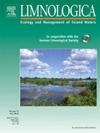The drivers of benthic macroinvertebrates communities along a subtropical river system: Sediment chemistry or water quality?
IF 2
4区 环境科学与生态学
Q2 LIMNOLOGY
引用次数: 0
Abstract
Despite a critical need for ecological risk assessment to preserve and manage aquatic ecosystems in rivers, the impacts of metal pollution on benthic macroinvertebrate species in sub-tropical river system have not been investigated. The main aim of this study was to examine benthic macroinvertebrate community composition in relation to metal concentrations sediments and other physico-chemical variables in the Mutshundudi River system. Benthic macroinvertebrate sampling and community composition analysis, sediment collection, processing, metal analysis and assessment of other variables in the river system were done across two seasons at 12 sampling sites, which were categorized into three segments: Upstream (sampling point 1-5), midstream (sampling point 6-9) and downstream (sampling point 10-12). The results from geo-accumulation (Igeo) values showed that sediments were loaded with Na, Zn, and B in all river segments. Water quality ranged from good at upstream sites due to low anthropogenic activities to very poor in downstream sites due to sewage and urban pollution. Sediments from the Mutshundudi river showed significant differences on high concentrations of metals (i.e., Mg, K, Na and Cu) and Seasonal variations (ANOVA, p < 0.01). Water and sediment chemistry were considered the driving factors of benthic macroinvertebrates, since species densities and composition reduced with a decline in water and sediment quality during both cool-dry and hot-wet seasons. Thus, measures of taxa richness, diversity and densities of macroinvertebrates may provide information on the quality of a river system. Heavy metals, such as Mg, K, Na and Cu in river sediments may pose adverse impact on macroinvertebrate community structure.亚热带水系底栖大型无脊椎动物群落的驱动因素:沉积物化学还是水质?
金属污染对亚热带水系底栖大型无脊椎动物物种的影响尚不清楚,但生态风险评估是保护和管理河流水生生态系统的迫切需要。本研究的主要目的是研究木顺都底河水系底栖大型无脊椎动物群落组成与金属浓度、沉积物和其他物理化学变量的关系。12个采样点分为上游(采样点1-5)、中游(采样点6-9)和下游(采样点10-12),分两个季节进行了底栖大型无脊椎动物采样和群落组成分析、沉积物收集、加工、金属分析和河流系统其他变量评估。地质堆积(Igeo)结果表明,各河段沉积物均以Na、Zn、B为主。由于人为活动较少,上游地区水质良好,而下游地区由于污水和城市污染,水质很差。木顺都底河沉积物中重金属(Mg、K、Na和Cu)的浓度和季节变化均存在显著差异(方差分析,p < 0.01)。水和沉积物化学被认为是底栖大型无脊椎动物的驱动因素,因为在干冷季节和湿热季节,物种密度和组成随着水和沉积物质量的下降而减少。因此,测量大型无脊椎动物的类群丰富度、多样性和密度可以提供有关河流系统质量的信息。河流沉积物中Mg、K、Na、Cu等重金属可能对大型无脊椎动物群落结构产生不利影响。
本文章由计算机程序翻译,如有差异,请以英文原文为准。
求助全文
约1分钟内获得全文
求助全文
来源期刊

Limnologica
环境科学-湖沼学
CiteScore
3.70
自引率
5.90%
发文量
64
审稿时长
3 months
期刊介绍:
Limnologica is a primary journal for limnologists, aquatic ecologists, freshwater biologists, restoration ecologists and ecotoxicologists working with freshwater habitats.
 求助内容:
求助内容: 应助结果提醒方式:
应助结果提醒方式:


